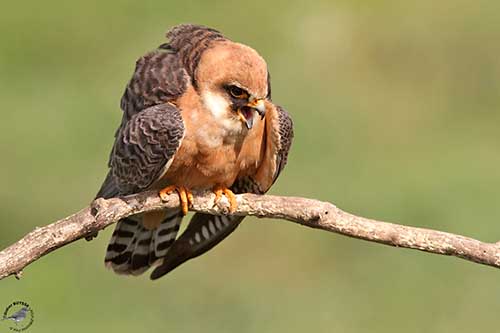
Fr: Faucon kobez
Ang: Red-footed Falcon
All: Rotfußfalke
Esp: Cernícalo Patirrojo
Ita: Falco cuculo
Nd: Roodpootvalk
Sd: Aftonfalk
Photographers:
John Anderson
John Anderson Photo Galleries
Didier Buysse
Vision d’Oiseaux
Jean Michel Fenerole
Photos d’Oiseaux du monde
Ingo Waschkies
My bird pictures on Pbase
Text by Nicole Bouglouan
Sources:
HANDBOOK OF THE BIRDS OF THE WORLD Vol 2 by Josep del Hoyo-Andrew Elliot-Jordi Sargatal - Lynx Edicions - ISBN: 8487334156
THE HANDBOOK OF BIRD IDENTIFICATION FOR EUROPE AND THE WESTERN PALEARCTIC by Mark Beaman, Steve Madge - C. Helm - ISBN: 0713639601
GUIDE DES RAPACES DIURNES – Europe, Afrique du Nord et Moyen-Orient de Benny Génsbol – Delachaux et Niestlé – ISBN : 2603013270
BIRDS OF PREY OF AFRICA AND ITS ISLANDS by Alan and Meg Kemp - Struik Publishers - ISBN: 1770073698
ROBERTS BIRDS OF SOUTH AFRICA by G. R. Mc Lachlan and R. Liversidge – The Trustees of the John Voelcker Bird Book Fund – ISBN: 0620031182
BIRDS OF THE MIDDLE EAST by R.F. Porter, S. Christensen, P Schiermacker-Ansen C.Helm - ISBN: 0713670169
Birds of Britain - The Web Magazine for Birdwatchers
Biodiversity Explorer – The Web of Life in Southern Africa
Wikipedia, the free encyclopaedia
European Raptors – Biology and Conservation
Field identification of Red-footed Falcon by Brian Small
Red-footed Falcon
Falco vespertinus
Falconiformes Order – Falconidae Family
INTRODUCTION :
The Red-footed Falcon is a gregarious bird of prey usually found in flocks. It often breeds in colonies, and sometimes solitary, using abandoned Corvidae or raptors’ nests.
It is an eastern European species and a long-distance migrant that winters in southern Africa. It feeds mainly on insects, but the chicks are mostly fed with small vertebrates.
The Red-footed Falcon is very close to Amur Falcon which was formerly a subspecies of F. vespertinus.
The population is decreasing due to habitat destruction and the species is currently listed as Near Threatened.

DESCRIPTION OF THE BIRD:
Biometrics:
Length: 27-32 cm
Wingspan: 74-75 cm
Weight: M: 115-190 g – F: 130-197 g
The Red-footed Falcon adult male has slate-grey plumage overall, but the underparts are paler and contrast with the chestnut lower belly, undertail-coverts and thighs. Head, neck and tail are darker, and the flight feathers are silvery above.
The bill has red cere and blackish tip. The eyes are dark brown, surrounded by bare, red eyering. Legs and feet are red too, with horn-coloured claws.
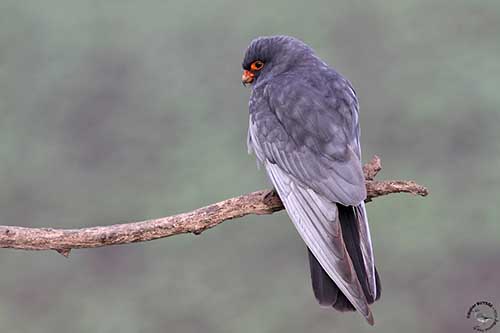
The adult female has blue-grey upperparts with transversal paler bands, whereas the underparts are plain pale rufous, including the underwing-coverts. Flight feathers and tail are grey with dark grey bars above and white bars below, and dark tips. On the head, crown and hindneck are rufous but the cheeks are white. We can see a blackish eye patch and a short moustache. The bare parts are mostly orange (not red). There are some individual variants.
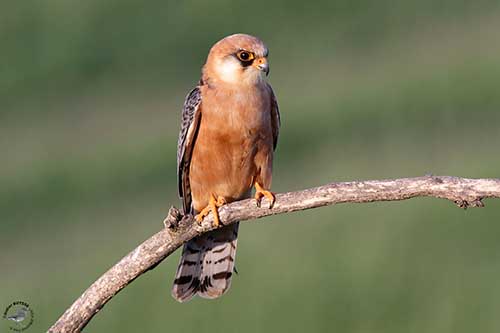
The juvenile resembles female but it has streaked breast and spotted underwing-coverts. The upperparts are mostly brownish with paler fringes forming scaled pattern. Cheeks and hindneck collar are buffy white. The dark moustache is short and pointed.
The first spring male is slate-brown above, with rufous and slate underparts. The adult plumage is gained at three years old after several variations of plumage.
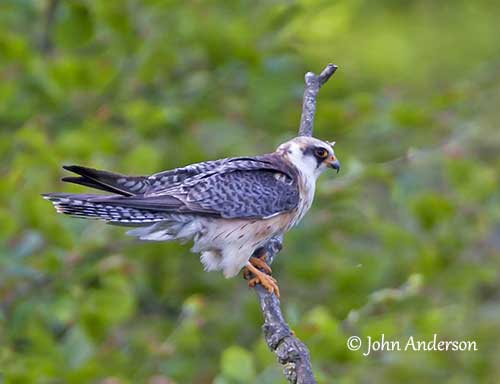
RANGE:
The Red-footed Falcon breeds in C Europe from Estonia, Slovakia and Hungary, E through NC Asia to extreme NW China and upper R Lena.
It winters in SW Africa, from Angola, Namibia and N South Africa, through Botswana to Zambia and Zimbabwe.
HABITAT:
The Red-footed Falcon breeds in wooded steppes, valleys, clearings, cultivated areas and pastures with clumps or fringes of trees, riparian woodlands, orchards, marshy lands and open taiga. It breeds usually in lowlands, but up to 1500 metres of elevation in Asia.
During winter in SW Africa, it frequents grasslands, savanna and scrubland. They form large nightime roosts in groves of eucalypts, but also in towns and villages. Several thousands of birds may gather at communal roosts.

CALLS AND SONGS: SOUNDS BY XENO-CANTO
The Red-footed Falcon is very noisy. The male gives high-pitched, rapid, scolding “kew-kew-kew…” when in flocks, and especially while gathering near the roost in winter. The female utters a slower “kwee-kwee-kwee…”
BEHAVIOUR IN THE WILD:
The Red-footed Falcon feeds primarily on insects, especially Orthoptera including grasshoppers, crickets and locusts. It also takes beetles, dragonflies, butterflies, moths and cicadas. On the wintering grounds, it feeds on flying ants and termites caught on the wing, and also locusts and grasshoppers.
During the breeding season, the chicks are mostly fed with small vertebrates such as small rodents and small birds, lizards and amphibians. It rarely takes adult birds in flight.
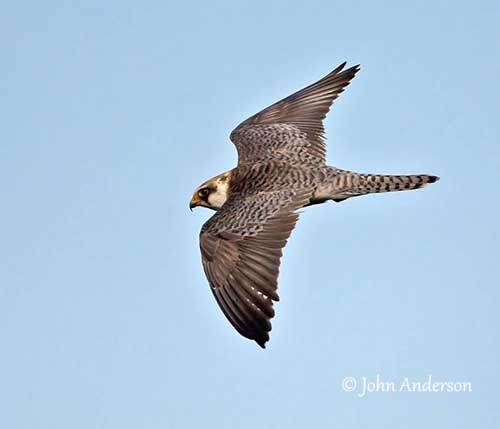
The Red-footed Falcon often flies low over rivers to catch insects. It also hunts from high posts and wires before to drop on insects. Several falcons may fly low together, soaring and hovering to detect preys on the ground. It also hunts by walking, running and hopping along ground. It hunts mainly in the morning, and in late afternoon until dusk.
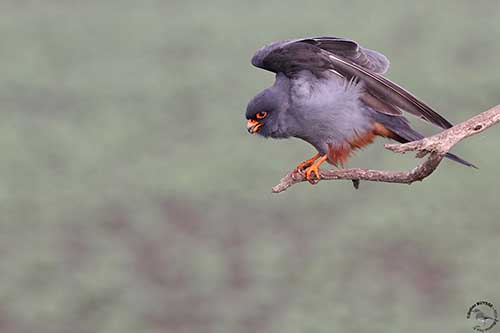
During the breeding season, both mates perform aerial displays fairly similar to displays of Common Kestrel. They circle in the air while the male feigns some attacks against the female. A variant shows the flying male diving on the perched female.
The pair-bond lasts only a single season. They often nest in colonies and use abandoned nests, especially Corvidae nests. However, they also nests as single pairs when the food resources are reduced.
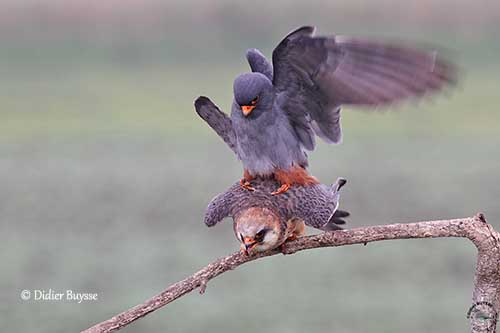
The Red-footed Falcon is migratory and spends the winter in southern Africa. It leaves the breeding grounds in August/September, crossing the E Mediterranean area in September/October. The return migration occurs in March/April, following a route over Italy and the Balkans, and they are often seen in Germany. They reach their breeding grounds in mid-April/mid-May.
They travel long distances usually at high altitude, between the breeding grounds and the wintering areas.
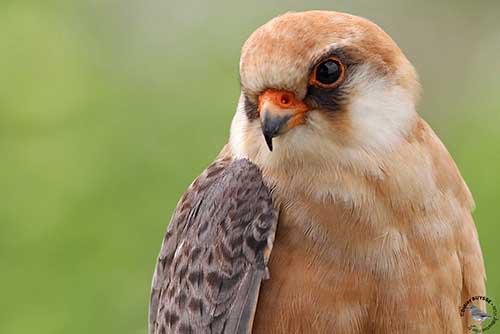
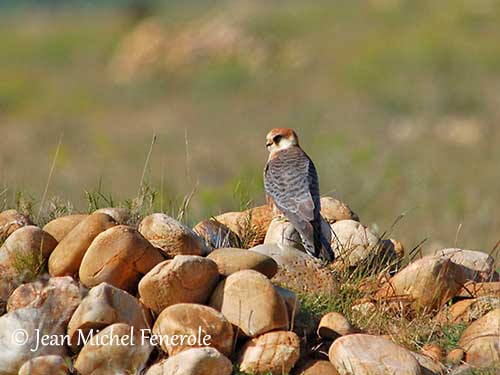
The Red-footed Falcon has light and fast flight on long, pointed wings, regularly pausing to hover while fanning the long, rounded tail. It often flies with loose wingbeats.
While hunting, it flies low over the ground or the water with rapid, shallow wingbeats.
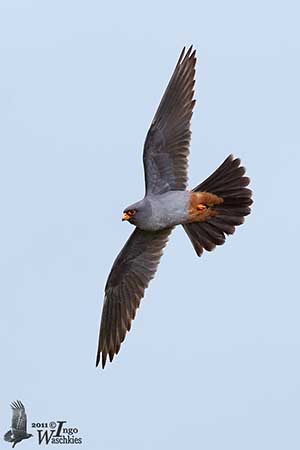
REPRODUCTION OF THIS SPECIES:
The breeding season occurs from mid-April to August, and the peak laying takes place mostly in late May.
The Red-footed Falcon nests as isolated pairs or in colonies of several hundreds of pairs. It uses abandoned nests, often of Corvidae and raptors, usually in the highest parts of trees, sometimes in cliffs, tree holes or bushes, occasionally on the ground among the vegetation. It also uses artificial nest boxes.
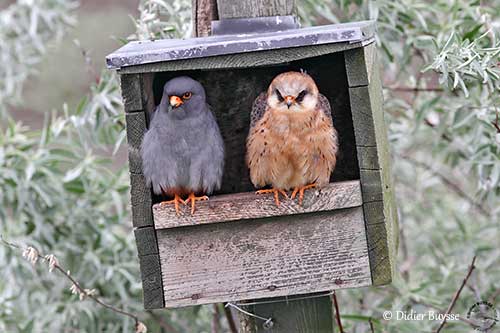
The female lays 2-5 buffy-white or pale brownish eggs with dark markings. Both adults incubate during 22-28 days. At hatching, the chicks have white down first, and then, buffy-grey above and paler below. The male brings food at nest for them, but later, both parents hunt for feeding the young. They fledge about 27-30 days after hatching, and become independent 1-2 weeks later.
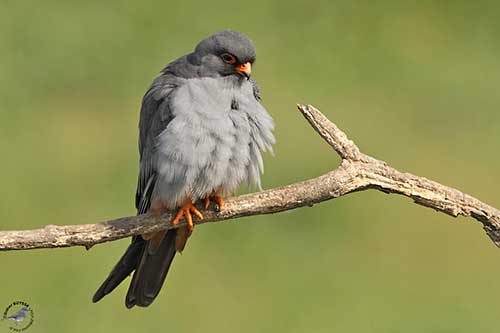
PROTECTION / THREATS / STATUS:
The population of the Red-footed Falcon is declining due to intensification of agriculture and increasing use of pesticides involving the reduction of insect populations. The trees used as suitable nest-sites are also destroyed for agricultural expansion. This species is hunted during the migrations, and suffers from illegal persecution.
The global population is estimated at 300,000/800,000 individuals and is decreasing, but numbers may vary according to food resources.
The Red-footed Falcon is currently listed as Near Threatened.
